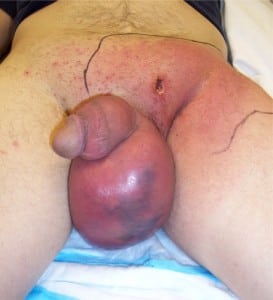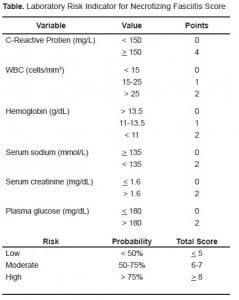| Author | Affiliation |
|---|---|
| Chelsea T. Wolf, MA | University of Colorado, Denver |
| Stephen J. Wolf, MD | University of Colorado, Denver Denver Health Medical Center, Department of Emergency Medicine, Denver, CO |
A 51-year-old male with hepatitis C and a history of intravenous (IV) drug use presented to the emergency department, reporting one day of worsening scrotal pain and swelling. He denied diabetes, trauma, or infection with HIV. His genitourinary examination revealed a draining lesion in his left inguinal region with surrounding induration and cellulitis extending onto his perineum. His scrotum was enlarged, edematous, and tender with a distinct region of ecchymosis (Figure). A calculated Laboratory Risk Indicator for Necrotizing Fasciitis (LRINEC) score was 7, indicating a moderate risk for necrotizing soft tissue infection (NSTI).1 Shortly after arrival, the patient was transferred to the operating room for surgical debridement, where the diagnosis of Fournier’s gangrene was confirmed.

Fournier gangrene is a rapidly-spreading NSTI of the perineum causing fascial and subcutaneous tissue destruction, with mortality rates of 17% to 34%.2 Risk factors for NSTIs and Fournier gangrene include diabetes, IV drug use, trauma, recent surgery, immune suppression (e.g., cirrhosis or malignancy), peripheral vascular disease, and morbid obesity.2,3 Fournier gangrene is classically associated with eccymotic changes, edema, erythema, and drainage from wounds. These findings, however, tend to arise late in the disease process. Early indicators that must heighten a clinician’s suspicion include severe genital pain and tenderness in the absence of external signs.
Multiple laboratory markers have been suggested as useful in diagnosing NSTIs.1,4 The LRINEC score (See Table) is a weighted point system of such markers often used to stratify patients into low, moderate, or high risk for NSTIs.1

Footnotes
Supervising Section Editor: Rick McPheeters, DO
Submission history: Submitted July 7, 2009; Revision Received August 17, 2009; Accepted August 18, 2009
Full text available through open access at http://escholarship.org/uc/uciem_westjem
Address for Correspondence: Stephen J. Wolf, MD, Department of Emergency Medicine, Denver Health Medical Center, Denver, CO 80204
Email Stephen.Wolf@dhha.org
Conflicts of Interest: By the WestJEM article submission agreement, all authors are required to disclose all affiliations, funding sources, and financial or management relationships that could be perceived as potential sources of bias. The authors disclosed none.
REFERENCES
1. Wong CH, Khin LW, Heng KS, Tan KC, Low CO. The LRINEC (Laboratory Risk Indicator for Necrotizing Fasciitis) score: a tool for distinguishing necrotizing fasciitis from other soft tissue infections. Crit Care Med. 2004;32:1535–41. [PubMed]
2. Santora T, Rukstalis DB. Fournier Gangrene. eMedicine Website. Available at:http://emedicine.medscape.com/article/438994-overview. Accessed July 1, 2009.
3. Anaya DA, Dellinger EP. Necrotizing Soft-Tissue Infection: Diagnosis and Management. Clin Infect Dis. 2007;44:705–10. [PubMed]
4. Wall DB, Klein SR, Black S, de Virgilio A Simple Model to Help Distinguish Necrotizing Fasciitis from Nonnecrotizing Soft Tissue Infection. J Am Coll Surg. 2000;191:227–31. [PubMed]


